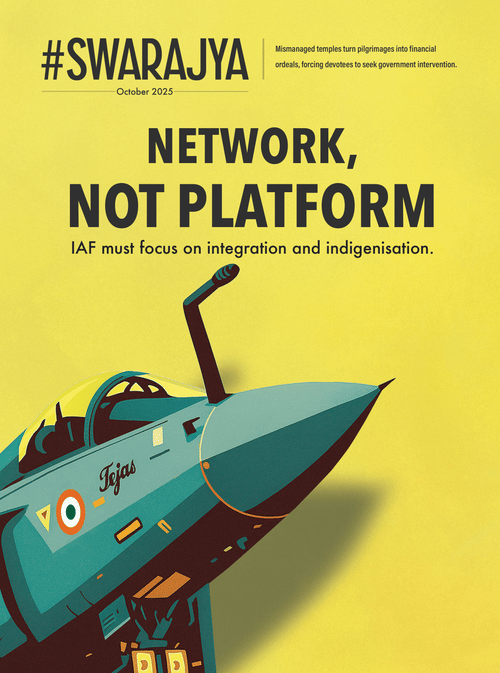Legal
Why Sanjeev Sanyal's Critique Must Force The Judiciary To Face The Mirror
Shinjani Agnihotri and Ananth Krishna
Sep 29, 2025, 12:19 PM | Updated 10:02 PM IST
Save & read from anywhere!
Bookmark stories for easy access on any device or the Swarajya app.


Sanjeev Sanyal, in his recent address during Nyaya Nirmaan 2025 conference, made a bold but necessary assertion that the judiciary has become “the single biggest hurdle” in India’s journey toward Viksit Bharat. The ensuing uproar from the legal fraternity was as predictable as it was disappointing. This refusal to engage with the substance of Sanyal’s argument has more to do with professional pride than to serve the cause of justice.
While his comments were perceived as an attack on the judiciary as an institution, it was a mirror held up to the system and a timely call for introspection and reform. The backlash only fortifies his point, that the legal fraternity refuses to even acknowledge the cracks in its own house.
The peculiarity of legal pedigree is not just in accepting things as they are but facing the objective truth, which is that no arm of the government, be it the legislature, the executive, or the judiciary, is perfect. The possibility of reform is negligible if the underlying institutions are not open to scrutiny.
Just look at the numbers of what the Indian judiciary is grappling with: a staggering backlog of 4.82 crore cases. Although the number of cases being disposed of is at an all time high, the number of cases instituted have also grown exponentially. This indicates that more steps are required to ensure that the delivery of justice does not suffer from systemic inefficiencies.
The problem is likely to worsen if the status quo is glorified, and no efforts are made to mitigate the issue.

The refusal to acknowledge the judicial system’s own failings on this topic is all-pervasive. Former CJI D.Y. Chandrachud, for example, recently pushed back against Sanyal, arguing that delays are caused by poor infrastructure and excessive government litigation, not judicial inefficiency. At the same time, multiple efforts have been made from the Government of India’s side to limit appeals. The spiral in case backlogs being attributed to infrastructure and government litigation completely ignores the judiciary’s own role in it.
Infrastructure alone cannot solve these deficiencies. You could build new courtrooms tomorrow, but if judicial recruitment remains irregular, if career progression stays stagnant, and if judicial activism continues to disrupt economic outcomes, delays and unpredictability will persist. As always, the truth is layered. Better infrastructure is necessary, but not sufficient. The judiciary must also embrace accountability, efficiency, and openness to change. Without that, India’s ambition of becoming Viksit Bharat will remain hostage to systemic inertia.
The problem extends beyond mere delays. Judicial activism, however well-intentioned, contributes towards a hostile environment for businesses. Investors crave certainty, not unpredictable court intervention that takes decades to be settled. Businesses live in limbo because contracts cannot be enforced on time. Judges are stretched thin, yet instead of demanding reforms to ease this burden, the legal community hides behind lofty rhetoric. Celebrating the undeniable brilliance of our judges while ignoring the mountain of pending cases is like praising a surgeon while his patients die waiting for an operation.
Take the Bhushan Steel case for example, where the Supreme Court threw out a resolution plan on procedural grounds, despite no material breach. The decision wiped out investor confidence overnight. Though the court has since reversed its decision, the damage is already done. In business, delayed justice is a lost opportunity. This is not the first time that the Court’s decision has hit investor confidence.
Environmental litigation such as the Vanashakti cases has repeatedly delayed critical infrastructure projects, closing the door for exemption regimes and mandating that even minor violations of the EIA regime cannot be rationalised. Such interventions inadvertently ensure that development projects are throttled while judicial resources are drained. For a country chasing Viksit Bharat, this approach is self-defeating.
The rot is structural and must be viewed from a reformatory mindset. With an astonishing 5320 vacancies of judicial officers in lower courts, it is clear that vacancies plague the lower courts because of the higher judiciary’s absolute control over appointments under a system that has been criticised for its opacity. Striking down of the National Judicial Appointment Commission was a profound blow to transparency. A system where judges appoint judges, shielded from external oversight, is not prevalent in any other democracy, and for good reason. The vacancies and the issues of representation in the judiciary (keep in mind that there is just a single female justice in the Supreme Court) are entirely down to the choices of the judiciary itself.
The inefficiency of the judicial system is even more glaring when one looks at the issues in the lower courts. Recruitment exams are irregular and eligibility rules change on a whim, throwing the career prospects of millions of young law students into the abyss, as happened recently by mandating 3 year practice. Career progression is painfully limited, leaving young judges demotivated. For those who are still unclear, the underlying message is that reforms are welcomed, as long as they do not reach the judiciary.
A glance at the status of judicial exams in a few prominent High Courts gives us an insight into the problems in this system.

Those aspiring to join the lower judiciary have to wait around for random and unconnected announcements, with prelims, final exams, and interviews conducted in a disparate and unorganised manner. Those successful in entering these services cannot realistically hope to enter the High Courts, and their treatment under the superintendence of the High Courts is a saga in themselves.
A constructive solution here is the creation of an All India Judicial Service (AIJS) examination that is transparent, nationwide, and merit-based. It would formalise recruitment, ensure consistency across states, and create a larger pipeline of qualified judges. This is the kind of reform that can ease burdens and restore public faith, yet the legal fraternity has resisted it. This is despite the fact that Article 312 has an explicit reference authorising the Rajya Sabha to create such an AIJS.
The problems in the lower judiciary do not end there. The enforceability of contracts, the most basic function that we expect from our civil courts system in an economic sense, is completely absent. The push by the Modi Government to adopt Alternative Dispute Resolution (ADR) mechanisms, especially arbitration, is an attempt to circumvent the absolute dysfunction of our civil courts.
The judiciary is not alone in resisting the idea of change. The legal fraternity at large is equally responsible. A case in point is widespread opposition to decriminalising cheque-bouncing cases, citing that faith in the banking system is yet to be restored. A red-herring fallacy frequently brought up is that the legislature must relook at its litigation policy instead of attempting to reform the laws. This fails to consider that departmental thresholds have been introduced to ensure minor appeals do not plague the tribunals and courts. However, each reform is met with the same rhetoric of “protecting independence,” when in reality, it only perpetuates inefficiencies and overload.
The legal fraternity has, over time, become one of the biggest rent-seeking groups in India. This is not unique. Professional groups from doctors to accountants have historically exhibited cartel-like behaviour until regulatory reform forced accountability. The difference between other professional lobbies and lawyers is the outsized power and influence lawyers and the legal system hold in our polity, which is unrivalled. Almost any move that even marginally affects lawyers is unlikely to survive beyond proposals.
The issues within the legal structure also affect the lawyers themselves negatively. The arbitrary distinction between lawyers from “senior advocates” functions less as a meritocracy and more like a medieval guild, designed to inflate costs and lock out younger talent. This is exactly what Sanjeev Sanyal pointed out in his speech. We are clinging to the feudal past in the name of harmless traditions. It is a constant reminder that officers of courts seldom stop to introspect on whether the system has placed itself above the very citizens it is meant to serve.
The same resistance to reform was evident in the debate over providing restrictive access to the Indian legal market for foreign lawyers. When the Bar Council of India (BCI) attempted to regulate and gradually open the Indian legal market on a reciprocal basis in 2022, lawyers did not engage constructively. Instead, they outright rejected the idea and even filed petitions in the Delhi High Court to block it, while missing the core point, which was reciprocity. It is pertinent to note that the BCI issued new regulations in 2025. One can hope that while there may still be scope for improvement, lawyers will engage constructively with the BCI this time instead of hogging up the court’s time in trivial matters.
Sanjeev Sanyal did not light a fire, he simply pointed out the smoke. Advocates are haranguing him for his views, or rather the distortions of them, instead of engaging with the substance of his arguments. If they did, or even attempted to do so, we would all be better off for it. Accountability and transparency must come from within the legal fraternity, beginning with lawyers who validate the status quo rather than pushing for change.
We can agree on a solution once we identify the problem.
The legal fraternity has a choice. It can continue to treat criticism as an insult, or it can heed the call for reform and become a true partner in India’s progress and journey to a Viksit Bharat. For the sake of the nation, let us hope it chooses the latter.
Shinjani Agnihotri is a consultant at NFPRC, and Ananth Krishna is Research Director, NFPRC.





